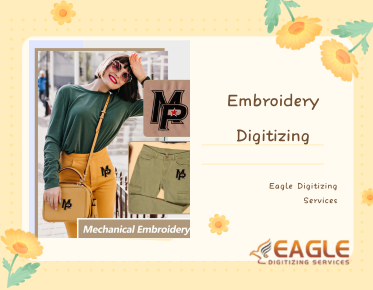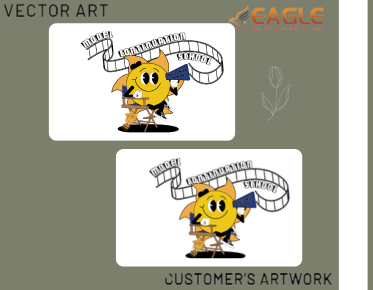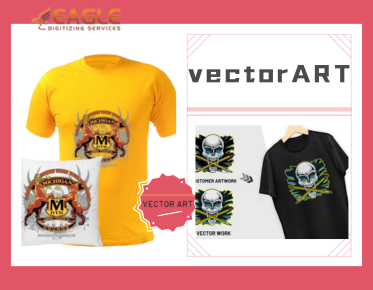Exploring the World of Embroidery Laser Technology/Eagle Digitizing
Embroidery has undergone a fascinating transformation from its humble origins to a high-tech marvel. Traditionally, this craft was executed by hand or with mechanical sewing machines, each stitch carefully placed by skilled artisans. Today, laser technology has revolutionized embroidery, integrating precision and efficiency into the process. This leap into the digital age has opened up new possibilities, blending artistry with cutting-edge technology. Read Here are Some Things That You Should Know When It Comes To Embroidery Digitizing!
Why Laser Technology is Revolutionizing the Embroidery Industry
Laser technology has injected a new dynamism into the embroidery industry. By utilizing lasers, embroidery now benefits from unprecedented precision, speed, and customization options. The ability to cut and engrave fabric with pinpoint accuracy has elevated the craft to a level of sophistication that traditional methods struggled to achieve. This technological revolution not only streamlines production but also expands creative potential.
Understanding Embroidery Laser Technology
What is Laser Technology in Embroidery?
Laser technology in embroidery involves using laser beams to perform tasks such as cutting, engraving, and etching on fabric. The laser's high precision allows for detailed and complex designs that are difficult to achieve with traditional methods. This technology operates through a process where a laser beam is directed at the fabric, altering its surface based on the design specifications.
How Lasers Work: A Simple Breakdown
Lasers work by emitting a concentrated beam of light that is focused through lenses to achieve the desired effect on a material. The intensity of the laser can be adjusted to cut through or engrave the fabric with extreme accuracy. This process involves controlling the laser’s power and movement to follow precise patterns, making it ideal for detailed embroidery work.
Types of Lasers Used in Embroidery
Different types of lasers are employed in embroidery, each suited to specific tasks. CO2 lasers are commonly used for cutting and engraving fabrics due to their ability to handle various materials with high precision. Fiber lasers, known for their efficiency and speed, are also used, particularly for engraving and marking on fabrics. The choice of laser type depends on the specific requirements of the embroidery project.
The Benefits of Using Lasers in Embroidery
Precision and Accuracy: The Laser Advantage
One of the most significant benefits of laser technology in embroidery is its precision. Lasers can execute intricate designs with exceptional accuracy, ensuring that every detail is captured perfectly. This level of detail is especially valuable for complex patterns and designs that require meticulous attention.
Speed and Efficiency: How Lasers Accelerate Production
Lasers dramatically increase the speed of embroidery production. Unlike traditional methods that may involve multiple steps and manual adjustments, laser systems can complete tasks quickly and efficiently. This speed not only enhances productivity but also allows for the rapid turnaround of custom orders.
Customization and Versatility: Expanding Design Possibilities
Laser technology expands design possibilities by allowing for a high degree of customization. Designers can create and modify intricate patterns and incorporate various elements with ease. The versatility of lasers means that designs can be adjusted and refined without the limitations imposed by traditional methods.
Consistency and Quality Control with Laser Technology
Maintaining consistency and quality is crucial in embroidery, and lasers excel in this regard. The precision of laser technology ensures that each piece produced is uniform and meets high-quality standards. This consistency is vital for businesses that require reliable results for large-scale production.
Comparing Laser Embroidery to Traditional Methods
Traditional Embroidery vs. Laser Embroidery: A Side-by-Side Comparison
When comparing traditional embroidery to laser embroidery, several differences emerge. Traditional methods rely on manual or mechanical stitching, which can be time-consuming and limited in terms of design complexity. In contrast, laser embroidery offers faster production, greater design accuracy, and the ability to handle intricate patterns with ease.
Cost Considerations: Initial Investment vs. Long-Term Savings
The initial investment in laser embroidery equipment can be substantial compared to traditional machines. However, this upfront cost is offset by long-term savings in labor and production time. The efficiency and precision of laser technology often result in lower operational costs and increased profitability over time.
Maintenance and Durability of Laser Machines vs. Traditional Machines
Laser embroidery machines generally require less maintenance than traditional machines, as they have fewer moving parts. The durability of laser systems often leads to lower repair costs and longer lifespans. Traditional machines, on the other hand, may need more frequent maintenance and repairs, impacting their overall cost-effectiveness
Key Components of a Laser Embroidery System
Laser Machines: Types and Features
Laser embroidery systems come in various types, each with specific features. CO2 laser machines are popular for their versatility in cutting and engraving. Fiber lasers offer high-speed and precision capabilities. Features to consider include the machine’s power, bed size, and control options, which influence the system’s suitability for different embroidery tasks.
Software for Laser Embroidery: Design and Control
Software plays a crucial role in laser embroidery, providing tools for designing and controlling the laser’s operations. Design software allows for the creation and modification of patterns, while control software manages the laser’s movements and settings. Choosing the right software is essential for achieving desired results and optimizing the embroidery process.
Fabric Compatibility: What Works Best with Laser Technology
Not all fabrics are suitable for laser embroidery, so understanding fabric compatibility is important. Fabrics such as cotton, polyester, and synthetics generally work well with laser technology. However, materials like delicate silks or highly elastic fabrics may require special handling or adjustments to achieve optimal results.
Designing for Laser Embroidery
Preparing Your Designs for Laser Embroidery
Preparing designs for laser embroidery involves ensuring that they are compatible with laser technology. This includes converting designs into vector formats, adjusting sizes, and setting parameters for cutting or engraving. Proper preparation ensures that the final product meets design expectations and quality standards.
Software Tips: Creating and Modifying Designs for Laser
When creating and modifying designs for laser embroidery, use vector-based software for precision. Ensure that designs are clean and free of unnecessary details that could affect the laser’s performance. Utilize software features such as layering and path editing to enhance the design’s suitability for laser processing.
The Role of Vector Art in Laser Embroidery
Vector art plays a significant role in laser embroidery due to its scalability and precision. Vector graphics are created using mathematical equations, which allows them to be scaled and manipulated without losing quality. This characteristic is ideal for laser embroidery, where accuracy and detail are paramount.
Applications of Laser Technology in Embroidery
Commercial vs. Personal Use: Where Laser Embroidery Fits
Laser embroidery technology has applications in both commercial and personal settings. In commercial use, it enhances production efficiency for businesses and enables customization at scale. For personal use, it offers hobbyists and enthusiasts the ability to create intricate and unique designs with ease.
Applications in Fashion: Enhancing Apparel with Laser Precision
In the fashion industry, laser technology is used to create elaborate patterns and embellishments on apparel. Designers can incorporate intricate designs, custom logos, and detailed motifs with precision. This technology allows for innovative fashion statements and high-quality garment personalization.
Home Décor and Gifts: Creative Uses for Laser Embroidery
Laser embroidery is also applied in home décor and gift items. From customized cushions and wall hangings to personalized gifts, laser technology enables the creation of unique and memorable pieces. Its ability to handle intricate designs makes it ideal for adding a personal touch to various home and gift items.
Corporate Branding and Promotional Items: Laser’s Impact
For corporate branding and promotional items, laser embroidery offers a professional and polished appearance. Companies can use laser technology to create high-quality logos and designs on promotional products such as bags, jackets, and caps. This precision enhances brand visibility and provides a premium look for promotional materials.
How to Get Started with Laser Embroidery
Choosing the Right Laser Embroidery Machine for Your Needs
When starting with laser embroidery, selecting the right machine is crucial. Consider factors such as the machine’s capabilities, features, and compatibility with your intended fabrics and designs. Research different models and consult with suppliers to find a machine that fits your specific needs and budget.
Initial Setup and Installation Tips
Proper setup and installation of a laser embroidery machine are essential for smooth operation. Follow the manufacturer’s instructions for assembly, calibration, and software installation. Ensure that the machine is placed in a suitable workspace with adequate ventilation and access for maintenance.
Training and Learning Resources for Beginners
Training and learning resources are valuable for beginners in laser embroidery. Seek out tutorials, online courses, and workshops to gain a solid understanding of the technology and techniques. Many suppliers offer training sessions or support to help you get started and become proficient in using laser embroidery equipment.
Troubleshooting Common Issues
Common Problems with Laser Embroidery and How to Fix Them
Common issues with laser embroidery can include misalignment, inconsistent cutting, and fabric burning. To address these problems, regularly calibrate the machine, check for software updates, and ensure that fabrics are properly prepared. Troubleshooting guides and support resources can also help resolve specific issues.
Maintaining Your Laser Embroidery Machine
Regular maintenance is key to ensuring the longevity and performance of your laser embroidery machine. Follow the manufacturer’s maintenance schedule, which may include cleaning, checking for wear and tear, and updating software. Proper maintenance helps prevent issues and keeps the machine running smoothly.
Ensuring Design Accuracy and Quality
To ensure design accuracy and quality, regularly review designs before processing and verify settings on the machine. Conduct test runs on sample fabrics to check for any discrepancies or issues. Consistent quality control practices help maintain high standards and achieve desired results in laser embroidery.
Innovations and Trends in Laser Embroidery
Emerging Technologies in Laser Embroidery
Emerging technologies in laser embroidery are continually advancing the field. Innovations such as improved laser systems, enhanced software features, and new materials are expanding the possibilities for laser embroidery. Staying updated on these advancements can provide new opportunities and techniques for creating unique designs.
The Impact of 3D and Mixed Media with Laser Technology
The integration of 3D elements and mixed media with laser technology is opening new creative avenues. Designers can combine laser-cut fabrics with other materials or incorporate three-dimensional elements into their work. This fusion of techniques adds depth and texture to embroidery projects, offering fresh and exciting design options.
Future Trends: What’s Next for Laser Embroidery?
The future of laser embroidery is poised for continued growth and innovation. Trends to watch include advancements in laser technology, new applications for different industries, and the integration of artificial intelligence for design optimization. As technology evolves, laser embroidery will likely become even more versatile and impactful.
Embroidery laser technology represents the future of textile design, combining precision, speed, and creative potential. As this technology continues to evolve, it promises to redefine the boundaries of what is possible in embroidery, offering new opportunities for designers and manufacturers alike. Embracing laser technology allows for the creation of intricate and unique designs, setting the stage for the next generation of textile innovation.



